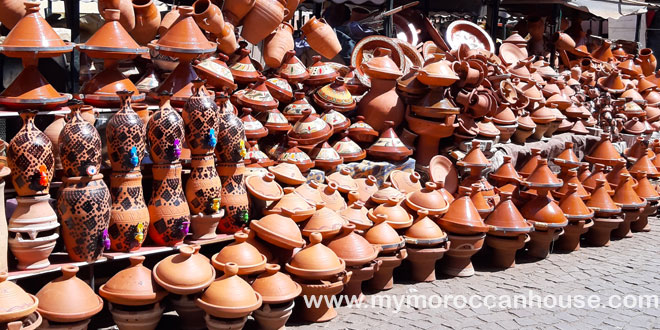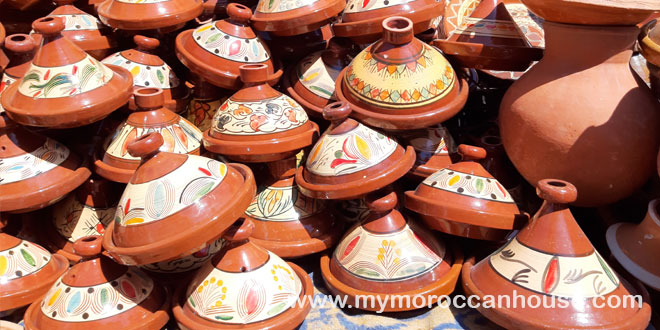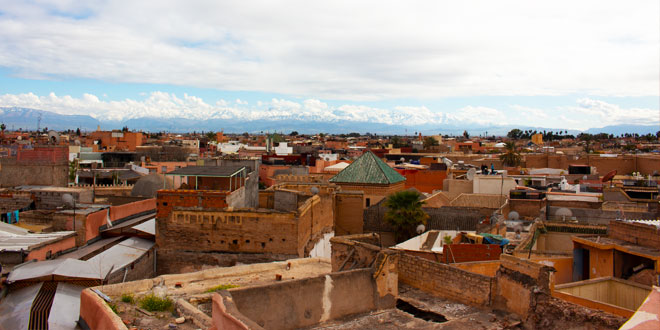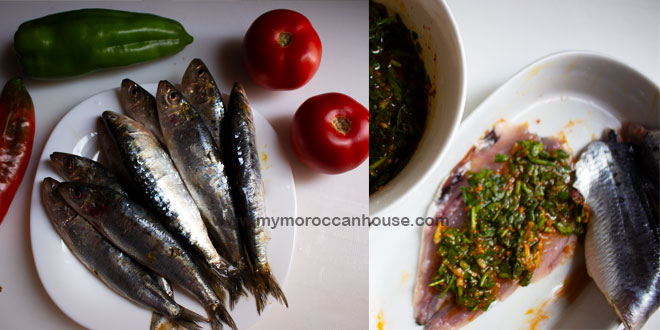are you a Moroccan food fan? you know that a tagine pot is a crucial piece of cookware to have in your kitchen. A tagine pot, also known as a tajine or a Moroccan tagine, is a traditional earthenware pot that is used to slow-cook dishes in the same way that a slow cooker or Dutch oven would. The distinctive cone-shaped lid of the tagine pot traps steam and moisture, infusing your dishes with flavor and ensuring that they are cooked to perfection.
But with so many different tagine pots on the market, how do you know which one to choose? That’s where this blog post comes in. As a Moroccan mom who always cooks in a tagine pot, I will show you the key factors to consider when selecting the best Moroccan tagine pot for you. I’ll cover everything from the material of the pot to its size and design, as well as the importance of heat distribution and ease of cleaning.
Towards the end of this post, you’ll have all the information you need to make an informed decision and choose the perfect tagine pot for your Moroccan cooking needs. So let’s start!

What is a Moroccan Tagine Pot?
let’s start with the basics: what is a tagine pot, and why are they so special? A tagine pot is a traditional cooking pot used in Moroccan cuisine. It’s named after the dish it’s used to cook, which is called a Tagine. The pot itself is typically made of clay or ceramic and has a unique conical shape with a pointed top and a flat bottom. The pointed top is designed to trap steam and moisture as the food cooks, resulting in tender, flavorful dishes.
Therefore, is buying a tagine pot worth it? We think so! While it may not be a necessity for every kitchen, a tagine pot can definitely add some versatility and flavor to your cooking. Plus, it’s a fun and unique piece to add to your collection of cookware. And who doesn’t love trying out new recipes and experimenting with different cuisines?
But don’t just take our word for it – try it out for yourself and see how a tagine pot can elevate your cooking.
The Role of Size and Capacity in Selecting a Tagine Pot
Now, onto the fun part: size and capacity. When it comes to tagine pots, bigger isn’t always better. In fact, the size of your tagine pot can greatly affect the outcome of your dishes. A pot that is too large may result in uneven cooking, while a pot that is too small may not be able to accommodate all of your ingredients.
Then, how do you know which size is right for you? Well, it all depends on what you plan on cooking. For dishes that serve two to three people, a small to medium size pot (around 9 inches in diameter) is a good choice. For dishes that serve four to six people, a medium to large size pot (around 11 inches in diameter) is a better fit. And for dishes that serve six or more people, a large pot (around 13 inches in diameter) is your best bet.
Now that you have a better understanding of the role of size and capacity in selecting a tagine pot, you can confidently choose the right size for your cooking needs.
The Importance of Heat Distribution and Retention in A Tagine Pot
You see, a tagine pot is designed with a unique cone-shaped lid that traps steam and circulates heat evenly throughout the dish. This not only cooks your food to perfection, but it also helps to retain its moisture and flavor.
But not all tagine pots are created equal. When shopping for one, make sure to look for a pot that is made from a material that is good at conducting heat, such as clay or cast iron. These materials will help to ensure that your tagine is cooked evenly and stays juicy and delicious.
So next time you’re planning on making a tagine, don’t forget the importance of heat distribution and retention in the pot. Trust me, your taste buds will thank you.
The Role of Traditional Moroccan Designs in Choosing a Tagine Pot
the beauty of a tagine pot goes beyond just its functionality. Traditional Moroccan designs and patterns on these pots add a touch of elegance and cultural flair to any kitchen. In fact, choosing the right tagine pot can be almost as much fun as actually using it to cook up some delicious dishes!
So why not add some exotic charm to your kitchen and try out a Moroccan tagine pot? You never know, it may just become your new favorite cooking tool. Plus, it’s the perfect conversation starter for your next dinner party. “Hey, have you tried cooking with a tagine pot? It’s amazing!” Trust us, your friends will be impressed.
The Importance of Ease of Cleaning and Maintenance in A Tagine Pot
Tagine pot is a traditional Moroccan cooking pot with a conical lid that is used to slow-cook dishes like stews, braises, and roasts. Nevertheless, it can also be a bit of a hassle to clean and maintain.
That’s why, when you’re looking for a tagine pot, you want to make sure it’s easy to clean and maintain. Trust me, you don’t want to be spending hours scrubbing burnt-on food and dealing with rust and other issues.
The good news is that there are now many tagine pots on the market that are designed with ease of cleaning and maintenance in mind. They often have a non-stick coating, glazed finish, or other features that make them a breeze to clean and maintain.
So, if you’re a fan of tagine cooking, be sure to look for a pot that’s easy to clean and maintain. Your taste buds (and your sanity) will thank you.
How Much Does a Tagine Cost?
if you’re thinking about buying a tagine pot, you might be wondering how much it will cost. The good news is that tagine pots can be found at a wide range of prices, dtaking into consideration material, size, and design.
In the USA, tagine pots can range in price from around $30 to over $100. In Morocco, on the other hand, you can find tagine pots for as little as $10 to $20. So, if you’re planning a trip to Morocco, be sure to keep an eye out for some great deals on tagine pots.
But no matter where you buy your tagine pot, be sure to consider the cost as well as the ease of cleaning and maintenance.

Tagine Pots: Glazed vs. Unglazed vs. Serving – Which is Right for You?
Now let’s take a closer look at the differences between glazed, unglazed, and serving tagine pots.
Glazed tagine pots are made with a glossy, waterproof finish on the exterior. This makes the pot perfect for cooking and serving dishes, as the glaze makes them easy to clean and keeps the food from sticking. Plus, the glossy finish adds a touch of elegance to any table setting.
On the other hand, unglazed tagine pots are more rustic and porous. This allows them to absorb the flavors of the dishes cooked inside, giving the food a more authentic and intense flavor. Nonetheless, unglazed pots require more care and maintenance, as they need to be seasoned and treated with oil before each use to prevent them from cracking. So, if you’re willing to put in a little extra effort, unglazed tagine pots are a great choice for the true Moroccan foodie.
Finally, there are serving tagine pots. These pots are typically made with a decorative glaze on the exterior but are not meant for cooking. Instead, they are used for serving food in a beautiful and traditional way. So, if you’re looking to impress your dinner guests with a unique and eye-catching serving dish, a serving tagine pot is the way to go.
Whether you’re a practical cook looking for a reliable cooking vessel, a flavor seeker looking for an authentic dining experience, or a host looking to impress your guests, there’s a tagine pot that’s right for you. Bon appétit!
Tagine Pot Maintenance Made Easy: Seasoning and Caring for Your Tagine Pot
But here’s the thing: a tagine is only as good as the seasoning and care that goes into it. That’s why we’re going to give you some tips and tricks for getting the most out of your tagine.
If you’re using a new tagine pot, you’ll need to season it before you use it for the first time. This will help to prevent the pot from cracking and ensure that your food cooks evenly. To season your tagine, simply rub it with a little vegetable oil, my choice would be olive oil.
Repeat the process 2 to 3 times. This will help to create a non-stick surface that will make cooking with your tagine a breeze.
Once your tagine is seasoned, it’s important to take care of it so that it lasts for years to come. To do this, you’ll want to avoid exposing your tagine to sudden temperature changes. This means that you should never put a hot tagine directly into cold water, and you should never put a cold tagine directly into a hot oven. Instead, allow your tagine to come to room temperature before exposing it to heat or cold.
Another important tip for caring for your tagine is to avoid using metal utensils when cooking with it. The clay material of the pot can be easily scratched by metal utensils, so it’s best to use wooden or silicone utensils instead.
Finally, when it comes time to clean your tagine, avoid using harsh detergents or abrasive sponges. Instead, simply wash it with warm water and mild dish soap, and then dry it thoroughly before storing it.
With these tips in mind, you’ll be well on your way to enjoying delicious, slow-cooked meals with your tagine pot. Happy cooking!


